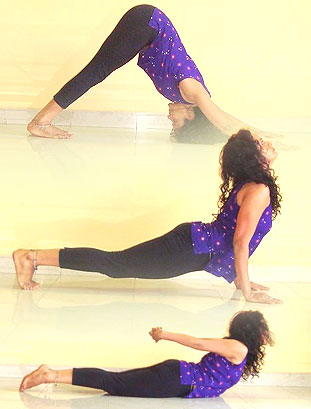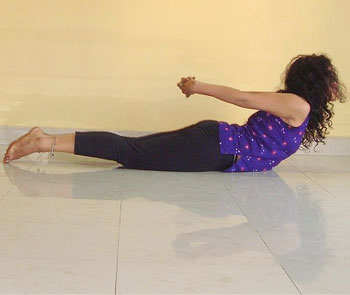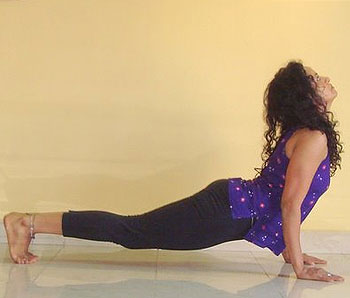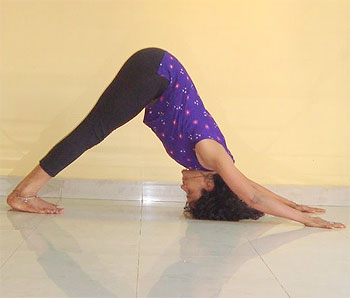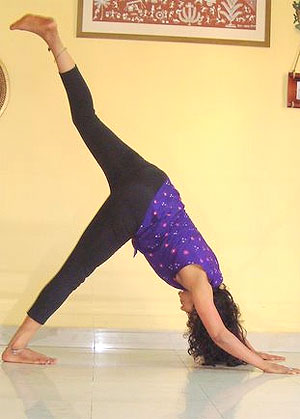 | « Back to article | Print this article |
Building super-stamina with yogic animal poses
Yoga borrows a lot from the animal world, to create poses. As we saw in the previous column on yogic bird poses, poses are named after creatures to copy a particular movement. But even more importantly, to give the practitioner a particular trait or strength of that animal.
For instance, the makarasana or crocodile helps develop tremendous spinal strength, borrowing the idea from the fact that the animal which lies prone most of the time nevertheless packs a tremendous punch in its tail, which extends along and connects with the spine.
Similarly, the frog pose or mandukasana can encourage hip flexibility and stamina, just like the hopping creature after which it is named. The tortoise pose or kurmasana can create a state of calm and stillness like that creature which is also known to live for very long due to its slow and calm breathing.
The several snake poses and their variations create super spinal flexibility and respiratory strength by opening up the chest. Some other poses named after animals are the horse pose (ashwasanchalanasana), camel (ushtrasana), hare (shashankasana), cat pose (marjariasana) and its several variations, lion pose (vyagharasana), simhagarjasana (lion-roaring pose) and so on.
If the bird poses create a state of lightness and balance, the animal poses create stability, strength and stamina.
Here, Shameem Akthar, yoga acharya, trained with the Sivananda Vedanta Yoga Center, will show you five animal poses from yoga which help up your mental and physical stamina.
Catch more of Shameem's yoga writings or upcoming workshops from http://jaisivananda.blogspot.com
(This column only seeks to share the author's enthusiasm towards yoga. Yoga is best learnt under expert guidance.)
Sarpasana (Snake pose)
Lie on your stomach. Place hands on either side of shoulder, with chin on ground, legs close, lightly touching. Place hands behind, interlocking fingers.
Inhale, lifting chin off the ground, simultaneously lifting interlocked hands behind so that they are off the back. Ensure both hands are tautly stretched. Continue breathing, pushing your chest up to hold the pose as long as is possible.
Release with an exhalation, gently bringing chin back to ground, releasing hands back to ground, near either shoulder.
Rest on your stomach, eyes shut, hands over each other, one cheek rested on the back of the hands, breathing normally (in the pose called makarasana or crocodile).
Benefits: Removes emotional blockages. Ups mood. Aids in respiratory ailments, powering the lungs. Heart and immune system are both impacted. Face becomes younger due to the powerful stretch from neck upwards. Spine enjoys a powerful traction.
Bhujangasana (Cobra pose)
Lie on stomach with chin on floor and palms either side of shoulder. Inhale. Raise chin and shoulder off the floor arching back. Eyes should look up at the ceiling, stomach should remain pressed on the floor so the arch is emphasized at the lower back.
Hold for a few seconds initially. Breathe normally throughout.
To return to starting position, exhale and lower back gently to the floor. Attempt thrice.
With a few weeks or even months of practice, you can do this pose only once but extend time to half a minute or more in the final position.
Avoid: In case of abdominal inflammations and flare-ups and severe lower backache and hyper-thyroidism.
Benefits: Same as above. It also helps with weight-loss due to pressure on thyroid at throat. Therapeutic value in diabetes due to pressure on abdomen.
Urdhva mukha svanasana (Upward-facing dog)
Lie on your stomach. Chin on the floor, palms flat on the ground on either side of your waist. Top of your feet should be flat on the floor.
Inhale, pushing down your palms and pushing yourself off the floor, so the torso lifts off as well as your knees, as shown in the photograph. Look ahead or overhead, keeping the torso straight ahead.
Continue normal breathing. Hold position as long as is possible. Exhale and release gently back to the starting position.
Avoid: If having wrist problems or headache.
Point to note: This is an advanced variation of the cobra and needs wrist strength and muscular stamina and may hence be attempted only by those who have done regular exercise.
Benefits: Same as above, though enhanced. Builds mental and muscular stamina.
Adhomukha svanasana (Downward-facing dog)
To do this pose, also referred to as parvatasana or mountain pose, kneel down.
Lean forward to place palms flat on ground in front. Exhale. Hoist hips off the floor, pushing down shoulders as you continue breathing, making following adjustments. Push down heels. Focus attention on stomach.
Apply pressure from shoulder blades. Move head as close to the ground as possible. Hold the pose as long as you can. Do several times initially.
Later, build up the stamina to hold pose for a minute or so.
Benefits: Is a powerful stamina-builder. Boosts calmness due to blood flow to brain. Balances blood pressure, both low and high. Alleviates all spinal problems. Tones arms and legs. Entire body is worked out. Removes wrinkles.
Ekapada adhomukha svanasana (One-legged downward-facing dog)
Do as you did for Downward-facing dog.
Inhale. Then lift right leg up and high, as shown, trying to keep that leg out straight behind. Exhale.
Drop it gently back to the ground. Repeat for the left leg.
Benefits: Same as above, more enhanced. Also involves strengthening balance.
